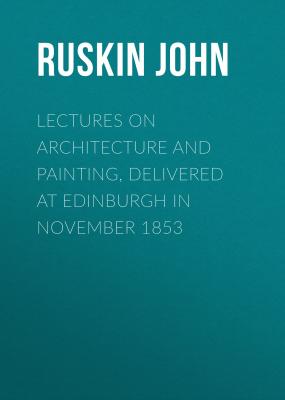Lectures on Architecture and Painting, Delivered at Edinburgh in November 1853. Ruskin John
Чтение книги онлайн.
Читать онлайн книгу Lectures on Architecture and Painting, Delivered at Edinburgh in November 1853 - Ruskin John страница 8
Название:
Автор:
Жанр:
Серия:
Издательство:
 on a windy and rainy day, till the servant comes from the end of the house to open it. You all know the critical nature of that opening—the drift of wind into the passage, the impossibility of putting down the umbrella at the proper moment without getting a cupful of water dropped down the back of your neck from the top of the door-way; and you know how little these inconveniences are abated by the common Greek portico at the top of the steps. You know how the east winds blow through those unlucky couples of pillars, which are all that your architects find consistent with due observance of the Doric order. Then, away with these absurdities; and the next house you build, insist upon having the pure old Gothic porch, walled in on both sides, with its pointed arch entrance and gable roof above. Under that, you can put down your umbrella at your leisure, and, if you will, stop a moment to talk with your friend as you give him the parting shake of the hand. And if now and then a wayfarer found a moment's rest on a stone seat on each side of it, I believe you would find the insides of your houses not one whit the less comfortable; and, if you answer me, that were such refuges built in the open streets, they would become mere nests of filthy vagrants, I reply that I do not despair of such a change in the administration of the poor laws of this country, as shall no longer leave any of our fellow creatures in a state in which they would pollute the steps of our houses by resting upon them for a night. But if not, the command to all of us is strict and straight, "When thou seest the naked, that thou cover him, and that thou bring the poor that are cast out to thy house."13 Not to the work-house, observe, but to thy house: and I say it would be better a thousandfold, that our doors should be beset by the poor day by day, than that it should be written of any one of us, "They reap every one his corn in the field, and they gather the vintage of the wicked. They cause the naked to lodge without shelter, that they have no covering in the cold. They are wet with the showers of the mountains, and embrace the rock, for want of a shelter."14
on a windy and rainy day, till the servant comes from the end of the house to open it. You all know the critical nature of that opening—the drift of wind into the passage, the impossibility of putting down the umbrella at the proper moment without getting a cupful of water dropped down the back of your neck from the top of the door-way; and you know how little these inconveniences are abated by the common Greek portico at the top of the steps. You know how the east winds blow through those unlucky couples of pillars, which are all that your architects find consistent with due observance of the Doric order. Then, away with these absurdities; and the next house you build, insist upon having the pure old Gothic porch, walled in on both sides, with its pointed arch entrance and gable roof above. Under that, you can put down your umbrella at your leisure, and, if you will, stop a moment to talk with your friend as you give him the parting shake of the hand. And if now and then a wayfarer found a moment's rest on a stone seat on each side of it, I believe you would find the insides of your houses not one whit the less comfortable; and, if you answer me, that were such refuges built in the open streets, they would become mere nests of filthy vagrants, I reply that I do not despair of such a change in the administration of the poor laws of this country, as shall no longer leave any of our fellow creatures in a state in which they would pollute the steps of our houses by resting upon them for a night. But if not, the command to all of us is strict and straight, "When thou seest the naked, that thou cover him, and that thou bring the poor that are cast out to thy house."13 Not to the work-house, observe, but to thy house: and I say it would be better a thousandfold, that our doors should be beset by the poor day by day, than that it should be written of any one of us, "They reap every one his corn in the field, and they gather the vintage of the wicked. They cause the naked to lodge without shelter, that they have no covering in the cold. They are wet with the showers of the mountains, and embrace the rock, for want of a shelter."14Конец ознакомительного фрагмента.
Текст предоставлен ООО «ЛитРес».
Прочитайте эту книгу целиком, купив полную легальную версию на ЛитРес.
Безопасно оплатить книгу можно банковской картой Visa, MasterCard, Maestro, со счета мобильного телефона, с платежного терминала, в салоне МТС или Связной, через PayPal, WebMoney, Яндекс.Деньги, QIWI Кошелек, бонусными картами или другим удобным Вам способом.